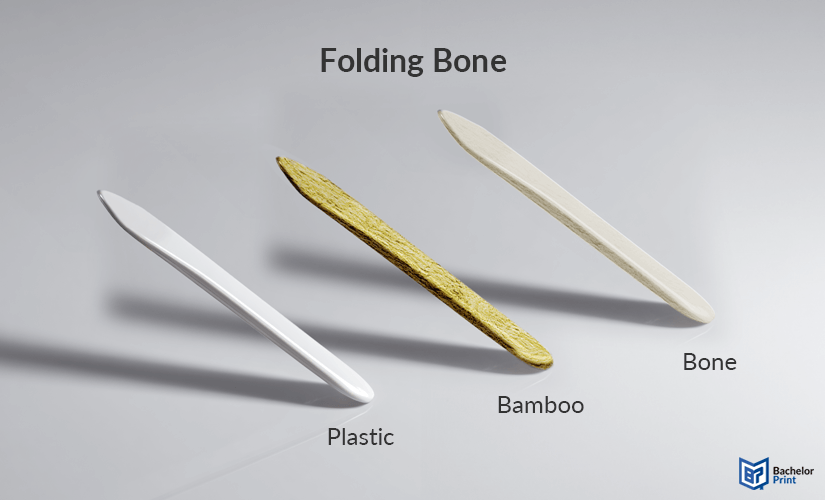
Folding bones are one of the most essential bookbinding tools as they’re used to crease, fold, and smooth paper or book cloth with precision. Traditionally made from polished bone, these tools help achieve professional folds in bookbinding and other paper craft. In this article, we’ll explore the uses, types, and maintenance of folding bones in bookbinding while also explaining some terms that come with this tool.
Inhaltsverzeichnis
Definition: Folding Bone
A folding bone (also: bone folder or bonefolder) is a traditional hand tool that is primarily used in bookbinding, paper folding, paper crafting, and other fine art projects that involve folding or creasing paper, cloth, or similar materials. This tool is quite versatile, as it can also be used for other projects, such as pottery and leather crafts. The primary function of a folding bone is to create sharp, precise creases and folds without tearing or scratching the material. The tool comes in various sizes and usually has a rounded or pointed end for scoring or folding and a smooth, flat surface for pressing and burnishing.

Printing services at BachelorPrint
- Individual solutions & personal support
- High print quality & fast production times
- Wide range of print products for every need
Learn more!
Uses
Below we have listed and explained some bookbinding terms that can be achieved with a folding bone, in case you aren’t familiar with them.
Scoring
The term “scoring” refers to the process of creating a shallow indent in paper to make it easier to fold and crease without cracking, thereby weakening the fibers. This can either be done with a scoring tool or a bone folder. This process is helpful for card making, origami with heavyweight paper, packaging, etc.
Burnishing
Burnishing is a finishing process that creates optimal shine on paper or other surfaces by applying pressure with a smooth, hard tool like a folding bone. Essentially, it smooths, polishes, and improves the appearance of folds. This process can be used in projects like bookbinding, leather crafts, advanced origami, card making, and printmaking.
Creasing
Creasing refers to the process of forming a defined fold in paper or cardstock. While this term is often confused with scoring, the two are distinct steps. Scoring is done to prepare the paper for folding, while creasing is the actual folding of the paper along the scored line.
Folding
The term “folding” is quite self-explanatory, as it refers to the actual process of bending paper along the crease line. It can be done in numerous ways, such as single folds, double folds, or accordion folds, depending on the project or binding method. If you’d like to know more about the types of bindings, click on the button.
History
The folding bone has been a fundamental tool in bookbinding and paper craft for centuries. Its origins, as far as we know, can be traced back to traditional bookbinding practices in both Europe and Asia, where artisans required a reliable tool to crease paper, parchment, and leather without damaging them.
Historically, they were made from polished animal leg bones — mostly from cows or deer — since bone is naturally smooth, durable, and less likely to leave residue on the material. In Japan, this folding tool is traditionally made from not just bone but also bamboo. The material and texture of bamboo allow for a firm grip and subtle control, which are especially necessary when practicing origami (the Japanese art of paper folding).
The folding bone was essential during the Golden Age of Bookbinding (16th-19th centuries) when books were bound by hand in workshops and monasteries. In East Asian traditions, similar tools were also used in origami and bookbinding, made not only from bone but oftentimes from horn, ivory, or bamboo. In regions such as Africa and Southeast Asia, buffalo horn was employed for folding tools, particularly in the form of so-called horn folders.
Nowadays, folding bones are made from alternative materials like Teflon — which can be a bit slippery and is bendy — and Delrin, a durable plastic. Some people even create their own folding bones using carved wood or 3D printing.
Your guide to print and production
- Information on print finishing & print processing
- Information on materials & optimal use of materials
- Information on printing processes & print production
Learn more!
Maintenance
Depending on the material, folding bones need to be taken care of well. This includes:
- Wiping after each use & putting it in a little bag
- Storing it in a dry place away from the sun or heat
- Using fine-grit sandpaper if the edge dulls & polish it
For natural materials, lightly oiling your folding bone can be necessary to prevent it from drying, cracking, or splintering. Mineral oil can be used for regular maintenance, jojoba oil for thorough conditioning, and walnut oil for special cases. Refrain from using regular cooking oil as it can make your folding bone smell rancid.
Some artisans simply suggest using water to clean it and then letting it dry overnight. In case you want to try the oil method, below are some tips.
For daily use
- Lightly oil it once a week
- Deep condition it monthly
For occasional use
- Lightly oil it every two weeks
- Deep condition it quarterly
FAQs
A folding bone is a hand tool used in bookbinding, paper crafting, origami, and print finishing to crease, fold, score, or burnish paper and other materials. It allows for sharp folds without damaging the surface.
Yes! Many traditional bone folders are still made from polished animal bone, due to its smoothness and strength. Modern alternatives now include Teflon, Delrin, wood, or 3D-printed folders.
Folding bones can be used to:
- Fold pages or covers
- Burnish glued or folded areas
- Score the paper before folding
- Smooth corners or pressed edges
- Crease paper or cardstock cleanly
Scoring: Press the bone lightly along a ruler to create a guideline on thick paper.
Folding: Bend the paper along the score line.
Burnishing: Run the bone firmly along the folded edge to flatten the crease.